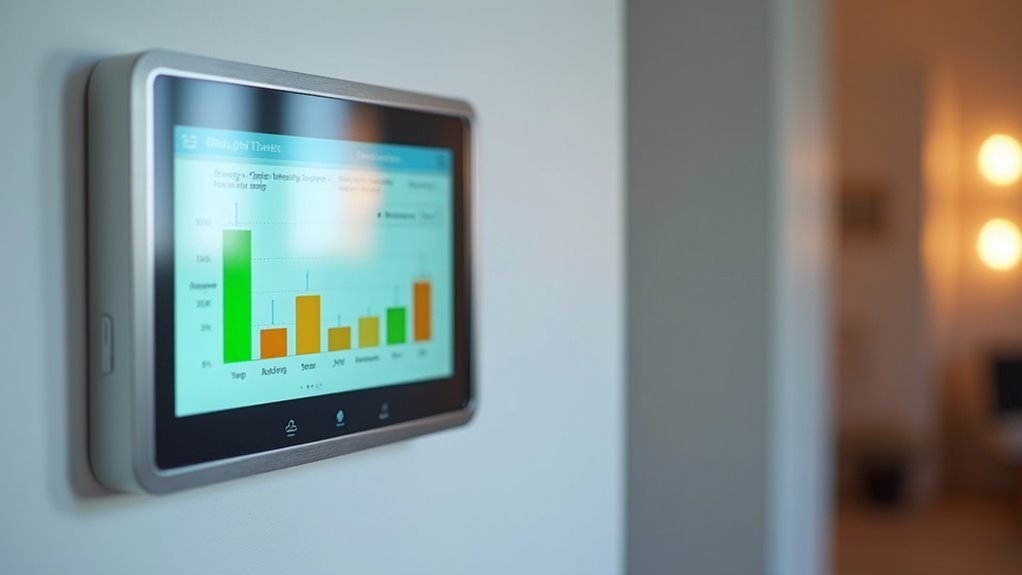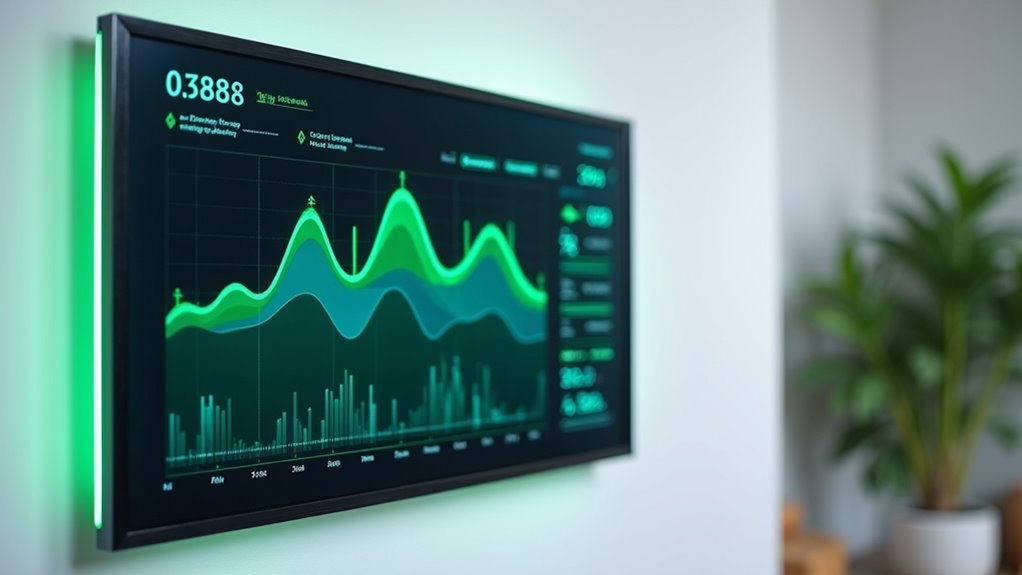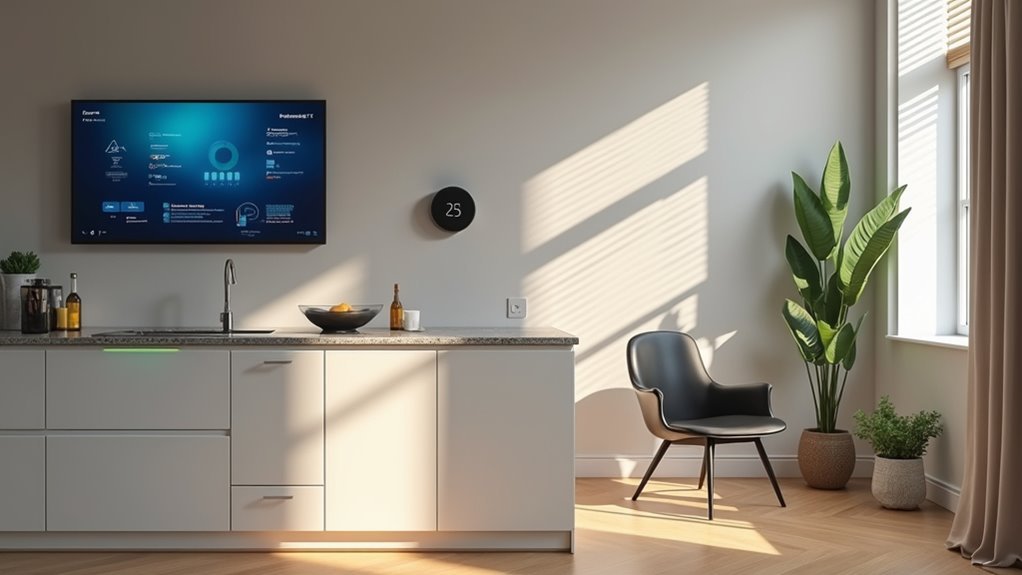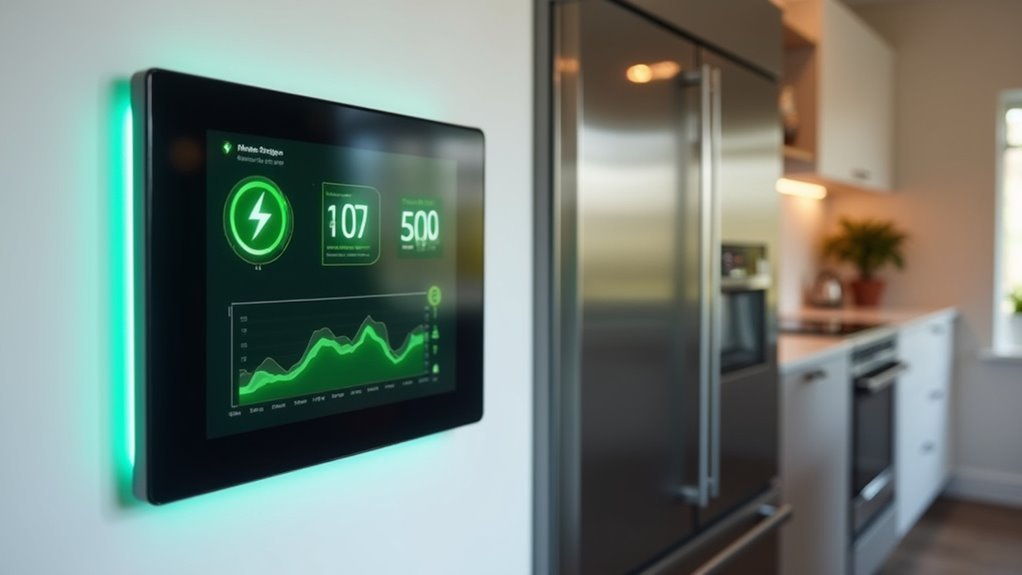You’ve probably noticed your energy bills climbing while your collection of smart devices grows. What you might not realize is that your smart home display could be the key to reversing that trend. These centralized hubs aren’t just convenient—they’re quietly revolutionizing how homeowners monitor and control their energy consumption. The difference between a display that drains power and one that saves it comes down to features most people overlook.
What Are Smart Home Displays and How Do They Impact Energy Usage

Smart home displays revolutionize how you interact with your living space by combining touchscreen interfaces with voice control to create centralized command hubs for your connected devices.
These versatile smart home hub solutions seamlessly integrate with energy efficient appliances, smart plugs, and lighting systems, allowing you to monitor and control energy consumption in real-time.
Modern smart displays serve as powerful central hubs that connect seamlessly with your home’s energy-efficient devices for comprehensive real-time monitoring and control.
You’ll discover significant benefits when using these displays to automate energy-saving routines. They detect occupancy through motion sensors and automatically adjust thermostat settings, schedule lighting, and manage appliance usage.
The energy efficient design of modern displays includes adaptive brightness and sleep modes that minimize power consumption when not actively used.
Top Energy-Efficient Smart Display Models for 2025
When you’re choosing a smart display for 2025, you’ll want to focus on models that offer genuine energy-saving features rather than just basic functionality.
The Google Nest Hub (2nd Gen) stands out with its Sleep Sensing technology that helps optimize your daily routines, while the Amazon Echo Show 8 (3rd Gen) provides automatic acoustic adjustments and broad compatibility with Matter, Thread, and Zigbee devices.
You’ll also need to compare actual power consumption between models to guarantee you’re getting the most efficient option for your smart home setup.
Energy-Saving Display Features
As energy costs continue rising and environmental consciousness grows, choosing a smart display with robust energy-saving features has become more important than ever.
Modern smart displays offer innovative technologies that’ll help you reduce energy consumption while maintaining functionality.
Key energy-saving features include:
- Automatic brightness adjustment – Motion sensors detect your presence and adjust screen brightness accordingly, preventing unnecessary power consumption when you’re not nearby.
- Acoustic optimization – Advanced sound processing reduces power requirements while maintaining audio quality, like the Amazon Echo Show 8’s automatic adjustments.
- Voice-controlled energy management – Direct control of lighting and appliances without physical interaction minimizes energy waste throughout your home.
These smart displays enable better management of connected devices, promoting efficient usage patterns that contribute to significant household energy savings while supporting your environmental goals.
Power Consumption Comparisons
While many consumers focus primarily on features and functionality, understanding the actual power consumption of different smart display models can greatly impact your long-term energy costs and environmental footprint.
The Echo Show 5 (3rd Gen) leads efficiency rankings at just 10 watts, perfect for bedside use. The Amazon Echo Hub follows closely at 12 watts, offering excellent smart home control capabilities.
Google’s Nest Hub (2nd Gen) consumes 15 watts while delivering superior sleep tracking without camera privacy concerns. The Echo Show 8 (3rd Gen) uses 50% less power than larger displays while maintaining robust auto-framing features.
These smart home devices typically consume 10-25 watts—significantly less than traditional monitors or TVs, making them cost-effective choices for continuous operation.
Real-Time Energy Monitoring Features in Smart Displays

Since smart displays have evolved beyond simple voice assistants and touchscreens, they now offer sophisticated energy monitoring capabilities that transform how you track and manage your home’s power consumption.
Devices like the Amazon Echo Show 8 integrate seamlessly with energy monitoring systems, delivering real-time energy monitoring data directly to your display.
These features enable extensive smart home control by:
- Device tracking – Monitor individual appliance consumption to identify energy-hungry devices
- Threshold alerts – Receive notifications when usage exceeds predetermined limits
- Automated controls – Schedule smart plugs and bulbs based on real-time consumption data
You’ll access detailed energy reports and usage statistics through your display, making informed decisions about consumption habits.
This integration allows you to implement energy-saving routines automatically, reducing waste while maintaining comfort.
Integrating Smart Displays With Home Energy Management Systems
You can transform your smart display into a central hub for home energy management by connecting it to your existing smart devices and energy monitoring systems.
Once integrated, you’ll access real-time energy consumption data directly on your display’s screen, giving you instant visibility into which devices are using the most power.
This setup also lets you control your entire smart device network and create automated energy-saving schedules that reduce waste without sacrificing comfort.
Display Energy Consumption Data
As home energy costs continue to rise, smart displays have emerged as powerful tools for monitoring and managing your household’s energy consumption in real-time.
These devices connect seamlessly with energy monitoring systems, transforming raw data into visual insights you can understand instantly. Your display becomes a central hub where you can track which appliances consume the most energy and spot unusual usage patterns.
Key benefits include:
- Real-time alerts – Get notified immediately when energy usage spikes unexpectedly
- Device-specific tracking – Identify your biggest energy consumers to prioritize efficiency improvements
- Historical data visualization – Compare usage patterns across days, weeks, and months
You’ll make more informed decisions about your energy habits when consumption data is readily visible on your smart display interface.
Control Smart Device Networks
Beyond simply displaying energy data, smart displays transform into extensive command centers that orchestrate your entire network of connected devices.
You’ll control smart devices like thermostats, plugs, and lighting systems from one central hub, eliminating the need to juggle multiple apps. Voice commands make managing your network effortless—simply tell your display to adjust multiple devices simultaneously, ensuring they’re only active when needed.
Your smart display’s integration capabilities let you create extensive schedules that optimize energy use across all connected devices.
You can program smart plugs to automatically shut off during peak energy hours while coordinating your thermostat and lighting systems. This centralized control approach delivers significant energy savings by preventing wasteful device operation and ensuring your entire smart home network functions efficiently together.
Automate Energy Saving Schedules
Smart displays elevate this centralized control by automatically creating and executing energy-saving schedules that respond to your consumption patterns and utility rates.
These intelligent devices connect seamlessly with your home energy management system, learning when you use the most electricity and optimizing appliance operation accordingly.
You’ll receive real-time feedback on energy usage, enabling immediate adjustments during peak hours. Voice control and touch interfaces make schedule modifications effortless, eliminating manual intervention when your needs change.
- Thermostat Integration: Smart displays work with devices like Google Nest Hub to automate heating and cooling based on occupancy
- Peak Hour Management: Automatically shift energy-intensive tasks to off-peak times for lower utility costs
- Significant Savings: Households typically reduce energy costs by up to 15% through effective automation
Smart Display Screen Technologies That Reduce Power Consumption
When choosing a smart home display, you’ll find that LED screen technology offers the most significant power savings, consuming up to 50% less energy than traditional LCD screens.
Your smart display can further optimize energy usage through adaptive brightness settings that automatically adjust to ambient light conditions, eliminating unnecessary power consumption.
Look for devices with energy-saving modes that dim or turn off the display during inactive periods, reducing energy usage by up to 30%.
Modern smart displays equipped with presence sensors detect when you’re in the room and adjust settings accordingly, preventing wasted energy.
Newer models with low-power components and efficient processors deliver 20-40% overall energy savings compared to older versions, making them excellent investments for eco-conscious households.
Automated Energy Controls Through Voice-Activated Displays

Voice-activated smart displays transform how you manage your home’s energy consumption by serving as central command hubs for all your connected devices.
These displays integrate seamlessly with smart thermostats like Ecobee and Nest, letting you adjust heating and cooling settings through simple voice commands. This convenience typically results in 10-12% annual savings on your heating and cooling bills.
Smart displays excel at energy management through automation and scheduling features:
- Schedule devices during peak hours – Program lights and appliances to turn off automatically, reducing electricity costs
- Real-time energy monitoring – Track consumption patterns through connected devices to identify wasteful habits
- Automated routines – Coordinate multiple devices to operate efficiently, potentially saving up to 30% in energy use when leaving home
Sleep and Standby Modes for Maximum Energy Savings
You’ll maximize your smart display’s energy efficiency by leveraging its built-in sleep and standby features that automatically reduce power consumption during inactive periods.
Your device’s automatic brightness adjustment responds to ambient lighting conditions, while programmable sleep modes can cut energy usage by up to 40% compared to displays running at full capacity.
These standby energy optimization settings not only lower your electricity bills but also provide valuable insights into your home’s overall energy consumption patterns.
Automatic Brightness Adjustment Features
As smart displays become central hubs in modern homes, their automatic brightness adjustment features represent a crucial advancement in energy-efficient technology.
These intelligent systems continuously monitor ambient light levels and adapt screen brightness accordingly, creating ideal viewing conditions while maximizing energy savings.
Your smart display’s adaptive brightness technology delivers significant benefits:
- Environmental responsiveness – Sensors detect surrounding light conditions and adjust display brightness automatically throughout the day
- Substantial energy reduction – Research shows adaptive brightness saves up to 20% more energy compared to standard displays with fixed brightness settings
- Enhanced user comfort – Screens remain perfectly visible without eye strain, whether you’re using them in bright daylight or dimly lit evening environments
This automatic brightness adjustment guarantees you’ll enjoy consistent performance while reducing your home’s overall energy consumption.
Sleep Mode Power Consumption
When you’re not actively using your smart display, sleep and standby modes become powerful tools for minimizing energy consumption without sacrificing functionality.
Popular models like the Google Nest Hub 2nd-gen and Amazon Echo Show 8 draw less than 2 watts while idle, representing up to 80% energy savings compared to active states.
During sleep mode, your device automatically dims screens and disables non-essential features. LED displays contribute to these impressive efficiency gains, consuming minimal power in standby states.
You’ll maximize these benefits by keeping firmware updated, as manufacturers continuously optimize energy-saving algorithms.
This smart energy consumption management makes your display an eco-friendly addition to your home automation system, delivering convenience while keeping electricity costs low.
Standby Energy Optimization Settings
Three key optimization settings can dramatically reduce your smart display’s energy consumption beyond basic sleep mode.
You’ll want to configure these advanced standby modes to maximize your device’s efficiency while maintaining functionality.
Energy-saving modes automatically adjust your display’s brightness and power consumption based on ambient light conditions and usage patterns.
This intelligent adaptation prevents unnecessary energy waste throughout the day. Standby modes can slash consumption from 10-15 watts during operation to just 0.5 watts during inactive periods.
- Customizable scheduling – Program automatic power-down during specific hours when you don’t need the device
- Ambient light sensors – Enable automatic brightness adjustments based on room lighting conditions
- Smart home integration – Connect with other devices for coordinated energy management during peak hours
Smart Lighting Integration With Display Controls
While traditional light switches require you to walk across the room, smart displays revolutionize how you control your home’s lighting by putting thorough management at your fingertips or within voice command range.
Smart lighting systems integrate seamlessly with devices like the Amazon Echo Show and Google Nest Hub, allowing you to adjust brightness, change colors, and set schedules remotely.
You’ll create automated routines that turn off lights when rooms aren’t occupied, potentially achieving energy savings up to 40%.
These displays serve as central hubs, coordinating multiple lighting zones throughout your home while providing energy usage monitoring features.
This insight into consumption patterns encourages more efficient habits and reduces wasted energy considerably.
Thermostat Management Through Smart Home Displays
You can control your home’s temperature effortlessly by speaking commands to your smart display, eliminating the need to walk to the thermostat or fumble with your phone.
Smart displays seamlessly integrate with popular thermostats like Nest and Ecobee, creating a centralized hub where you’ll view real-time temperature data, adjust settings, and monitor energy usage patterns.
This integration transforms your display into a powerful climate control center that responds to your voice while providing visual feedback on your home’s heating and cooling status.
Voice-Controlled Temperature Adjustments
As smart home displays become central command hubs for modern households, they’re revolutionizing how you control your home’s temperature through seamless voice commands.
Simply saying “Hey Google, set the temperature to 72 degrees” or “Alexa, lower the thermostat by 3 degrees” instantly adjusts your climate without lifting a finger. This voice control integration with your smart thermostat creates an effortless energy management experience.
- Instant adjustments: Make temperature changes from anywhere in your home without walking to the thermostat
- Hands-free convenience: Perfect when you’re cooking, cleaning, or have your hands full with daily tasks
- Energy savings: Studies show smart thermostats reduce heating and cooling costs by 10-15% through optimized usage patterns
Smart Display Integration
Beyond simple voice commands, smart displays like the Google Nest Hub and Amazon Echo Show transform your thermostat management into a detailed visual experience.
Smart display integration with thermostats like Ecobee and Nest lets you control heating and cooling through intuitive touch interfaces and voice commands.
You’ll access advanced features like scheduling, temperature adjustments, and energy monitoring directly from your display.
The geofencing capability automatically adjusts your thermostat when you leave or return home, maximizing energy savings without effort.
Real-time feedback shows your current consumption patterns, while historical data and weather forecasts generate personalized suggestions for optimizing efficiency.
This extensive integration empowers you to make informed decisions about your heating and cooling habits, greatly reducing energy bills through smarter home management.
Energy Usage Analytics and Reporting Capabilities
While traditional energy bills provide only monthly summaries, smart home displays deliver real-time energy usage analytics that transform how you understand and manage your household consumption.
These devices integrate seamlessly with energy monitoring equipment to provide thorough insights into your consumption patterns.
Smart displays seamlessly integrate with monitoring systems to deliver comprehensive insights into your home’s energy consumption patterns.
Your smart display becomes a powerful energy monitoring dashboard that reveals:
- Which appliances consume the most electricity throughout the day
- Peak usage times when you’re spending the most on energy costs
- Actionable suggestions for reducing consumption and lowering bills
Advanced analytics help you identify when to shift energy-intensive activities to off-peak hours, potentially cutting electricity costs.
Through detailed reporting and timely notifications, your smart display encourages more efficient habits, ultimately contributing to meaningful reductions in household energy consumption.
Cost Comparison of Energy-Saving Display Features
When evaluating smart displays for energy efficiency, you’ll find that investing in models with advanced energy-saving features pays off through reduced utility bills and lower device operating costs.
Smart displays like the Google Nest Hub 2nd Gen and Echo Show 8 enable you to control energy consumption through smart home integration, managing lighting and temperature effortlessly.
These devices help reduce energy usage by at least 75% when combined with smart bulbs compared to traditional incandescent lighting. Their adaptive brightness settings automatically adjust based on ambient light, conserving additional energy.
Installation Tips for Optimal Energy Efficiency
After selecting an energy-efficient smart display, proper installation becomes your next step toward maximizing power savings.
Strategic placement and configuration directly impact your device’s energy consumption and overall efficiency.
Choose locations with abundant natural light to reduce dependence on artificial lighting. Keep displays away from heat sources and direct sunlight to prevent cooling components from working overtime.
Configure energy-efficient settings immediately after installation, including adaptive brightness and sleep mode features.
Essential installation tips for maximum efficiency:
- Connect your display to energy monitoring systems for real-time consumption tracking
- Position devices in areas where voice commands can effectively control other smart home devices
- Enable automatic brightness adjustment to match ambient lighting conditions throughout the day
Smart Display Placement Strategies to Minimize Power Draw
Where you position your smart display determines how hard it works and how much energy it consumes. Strategic smart display placement can greatly reduce power draw while maximizing functionality.
| Location | Energy Impact | Benefits |
|---|---|---|
| Away from sunlight | Prevents overheating | Reduces cooling needs |
| Central areas | Serves multiple rooms | Fewer devices required |
| Near sensors | Better ambient detection | Optimized brightness |
You’ll save energy by positioning displays in kitchens or living rooms where they serve multiple functions, eliminating the need for additional devices. Keep them away from direct sunlight to prevent overheating and excessive cooling demands. When you integrate displays with energy management systems, they’ll automatically monitor and optimize your home’s power usage through smart plugs and sensors.
Measuring Your Energy Savings With Smart Display Technology
Strategic placement sets the foundation for energy efficiency, but tracking your actual savings requires the right measurement tools. Smart displays transform energy monitoring from guesswork into precise data analysis.
You’ll see real-time consumption patterns that reveal which energy-efficient smart home devices deliver the biggest impact on your bills.
Your smart display acts as a thorough energy command center, giving you actionable insights into daily usage trends. You’ll receive personalized alerts when energy consumption spikes unexpectedly, helping you address wasteful habits immediately.
Key measurement capabilities include:
- Real-time tracking of individual device energy consumption with detailed analytics
- Automated scheduling features that calculate exact savings from optimized usage patterns
- Monthly comparison reports showing utility bill reductions and efficiency improvements
This data-driven approach helps you make informed decisions about future energy-saving investments.
Frequently Asked Questions
Do Smart Home Devices Save Energy?
Yes, you’ll save energy with smart home devices. Smart thermostats cut heating costs by 15%, LED bulbs use 75% less energy, and smart plugs eliminate vampire power consumption that wastes 5-10% of electricity.
What Is the Best Smart Home Display?
You’ll find the Amazon Echo Show 8 (3rd Gen) offers the best balance with its 4.5/5 rating, automatic acoustic adjustments, and excellent integration for controlling smart home devices efficiently.
How to Set up a Smart Home for Energy Efficiency?
You’ll maximize energy efficiency by installing smart thermostats for 20% heating savings, using smart plugs to eliminate vampire energy, switching to LED smart bulbs, and adding smart irrigation controllers for ideal water usage.
How to Save Money With a Smart Home?
You’ll save money by automating lights and appliances through smart plugs, installing smart thermostats that optimize heating schedules, and using energy monitors to identify wasteful devices and adjust usage patterns.





Leave a Reply